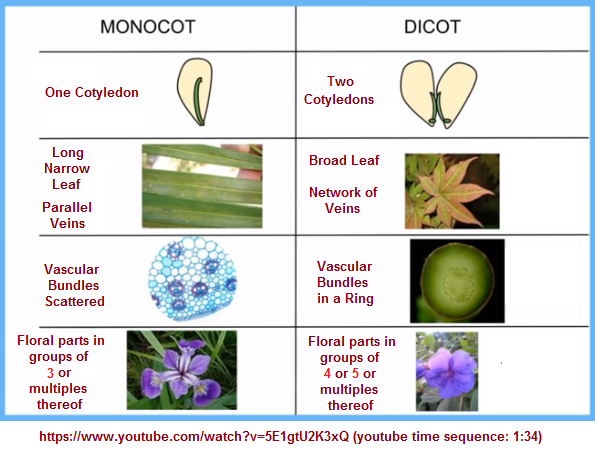~ 41 A ~
~ The Study of Threes ~
http://threesology.org
Researchers as of 8/29/2019
| Devil's Advocate Series: | ||||||||
|---|---|---|---|---|---|---|---|---|
| 1 | 2 | 3 | 4 | 5 | 6 | 7 | 8 | 9 |
| 10 | 11 | 12 | 13 | 14A 14B |
15 | 16 | 17 | 18 |
| 19 | 20 | 21 | 22A 22B |
23 | 24 | 25 | 26 | 27 |
| 28 | 29 | 30 A 30 B |
31 | 32 | 33a 33b 33c |
34 | 35 | 36 |
| 37 | 38 | 39 | 40 | 41 A 41 B |
||||
Out of all the domesticated plants humanity has at its disposal to be used for food, it should be rather surprising to find that out of them all, it is just three (wheat, maize, and rice) which make up the majority of humanity's calories from crops. In this article it is said that Nearly half our calories come from these 3 crops.
The fact that we have yet another "three" reference at this point in what may ultimately turn out to be a short timeline of humanity, needs to be included in the ongoing development of a "Threesological" timeline account of history involving the rather small expressions of biologically-related uses of this pattern (in physiology, genetics, evolution, thought processing, mechanical/electrical/chemical constructions, etc...). Again, let me state that such an approach involves the "presence, absence and inter-mittant" occurrence of three-patterned ensembles. When we encounter a two, a seven, a four, an eleven, or some number other than three, yet on accounting for this and making a collection of such number occurrences, absences and intermittent presentations as well and then finding that the overall patterns of numbers is limited and that some number patterns are more or less present, absent or intermittent than others, has a significance in detailing human cognition, and the possibility that we might well uncover an ongoing process external to human thinking that can be controlled by humans.
For example, the apparently non-evolving triplet code in DNA might well be cited as the expression of some purported "intelligent design", only in as much as there appears to be no widely distributed reference to publicly known research involving what might be an environmental influence for such a pattern, and that this assumed environmental influence is subject to change at any time, like the occasional flip-flop of the Earth's magnetic field. Just because we short-lived humans have not indicated any presence of such an event, does not mean it has not or will not occur. However, we need to differentiate the difference between speculative research inquires being developed by those who claim to be advocates of an "Intelligent Design" proposal involving some religious inclination, and those whose efforts are not so opinionated as to disallow any other evaluation to be experimentally testable and tested.
Yet, since so many theologians of the past took an avid interest is some sort of scientific investigation, it stands to reason their is a link to be recognized between their religious and science interests, though so very many emphasize their religious belief as the influence and reason of their interests, to the point of using scripture to defend against any attempted denouncement of their interest in science. Others use a reason that it is because they don't believe in religion that they took up an interest in some science pursuit. For myself, neither one of these "reasons" for being curious and putting patterns together is a very valid excuse. And no, don't try to pitch this as a middle lane, like someone walking down the middle of a road or street at night, having to alternate between whistling and keeping quiet because they imagine some possible menace leering at them from the shadows.
It is essential for researchers, despite any initial misgivings, to weigh the possibility of an "intelligent design" concept, even if they are agnostic or an avowed atheist (many of whom are preoccupied with talking about god and/or religion, thus having created their own type of religious-like fervor instead, but do not recognize the cognitive correlation of similar behavioral activities occurring between religious believers and those who claim themselves to be non-religious believers... since both activities have similar cognitive parallels of brain functioning despite assumed differences in content and application). I myself do not advocate the idea of "intelligent design" as related to a god or any particular religious orientation, but instead align it to that which creates circumstances or conditions from which patterns occur, of which non-patterns is also a pattern. Whereas we have recurring "Natural Laws", we can say that they are Nature and that Nature is not a god nor especially any evidence for the validity of a given religious belief, the laws need some means of being organized as they are.
This "means" can be described as the product of some "intelligent design", though the both the words "intelligent" and "design" are most likely misnomers and are more likely expressions used as projections of human ego-related themes of personal interest. But for the sake of discussion, so long as the discussion using the phrase "intelligent design" is not misconstrued to mean god and religion-based proclivities, it can be used as a generality for philosophical investigations. It is unfortunate that those wishing to use such a phrase can not surmount their emotional attachments and proceed to analyze recurrences of events (patterns) as those which need to be subjected to scientific inquiry, though many experiments are no doubt biased since patterns seen in experimentation can represent cultural orientations aligned with some purported value of truth, such as for example, swearing on a bible or similar book of claimed sanctity that binds one to telling the truth coupled with a three or 3-to-1 patterned phrase such as "tell the truth- the whole truth- nothing but the truth, so help me god", which reeks of being some sort of childish magical, superstitious, or conjuring-up vernacular akin to some religious-annotated "speaking in tongues" directive that also is reminiscent of the language used when a person attempts to contact the dead at a seance. The legal systems around the world, like that of the American practice, no doubt share in their own brand of a laughably comical practice.
While it may be a quirk in my mental character, (not to say I don't have one, two or three of them), I must say I like to listen to some speakers who advocate for an "Intelligent Design". Some of them have the purported science of their discussions so wrong, it's like listening to a comedian. They can be so stupidly funny! However, I don't mind being provided with an alternative view of material I am interested in at a given moment, since even stupid people can be visually creative and provide interesting perspectives in their attempted illustrations. I simply thank them for an attempt to be insightful, as I am of any child-like orientation found in artistic impressions, like the "food face" used by France in its government-described nutrition guideline, which should rightly be contrasted by the rather institutional-looking cafeteria tray-like image used by the United Kingdom (possibly influenced by a commerce-oriented government climate), and the trayless variety of the same sort of "civilized" mentality used by Mexico and other countries.
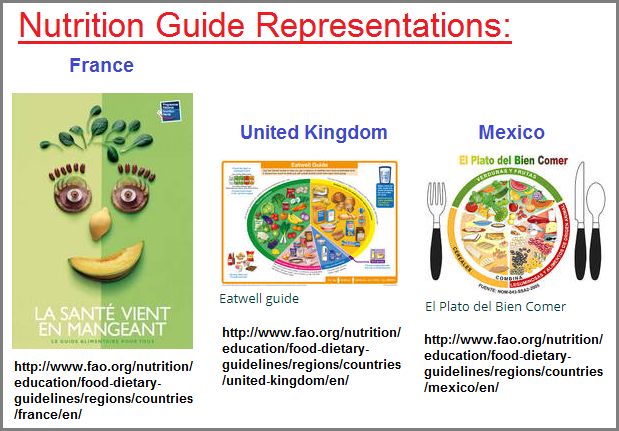
I say "civilized" because the depiction of three utensils by the Mexico version needs to be contrasted with the knowledge that the hands are very often used to eat various types of foods in general settings, (which include public settings such as roadside food truck distributions in the U.S., where food is served on a paper plate and people eating from them remind me of pets or stray animals being fed at the back steps of a business or home), and in fact we should make a world account of WHICH foods are being prepared and HOW they are prepared; so that what people choose for eating such foods may well direct them to purposely use their hands or fingers instead of utensils... and this behavioral "primivity" is being enforced by commercial practices such as fast food restaurants, convenience store purchases, and the many store items found in different cultures. It appears that the reasons, used as excuses, that it is easier and more convenient to use the hands for eating (as opposed to using utensils), can also be used to describe an inclination of the human species to remain in its multitude practices of primivity as well, sponsored by the business community, the government, and religions. This is an important point to make when discussing not only food but which types of foods are being grown, along with the justifications for such uses. An unconscious desire to have foods which permit people to use their hands as opposed to eating with utensils may have some unconscious influence on deciding which plants to grow and how such foods are eventually prepared... and perhaps the way we think about food and its personal and commercial applications. Preferences for food and environments in which food can be eaten with the fingers (hands), may play a large factor in deciding which foodstuffs are focused on for growing and researching.
Interestingly, when we look at the Nutrition guideline image of the United States presently being used, I see a dramatic shift in the mentality in an effort to produce what might be claimed as a simplified representation for the general public, to be contrasted with the former image which used the same description of usage for offering it as something that would have universal appeal and understanding. Let us look at the changing perspective of those involved with setting up the Nutrition guidelines for the U.S. government, because it is an issue which needs to be addressed by a larger perspective involving public opinion:
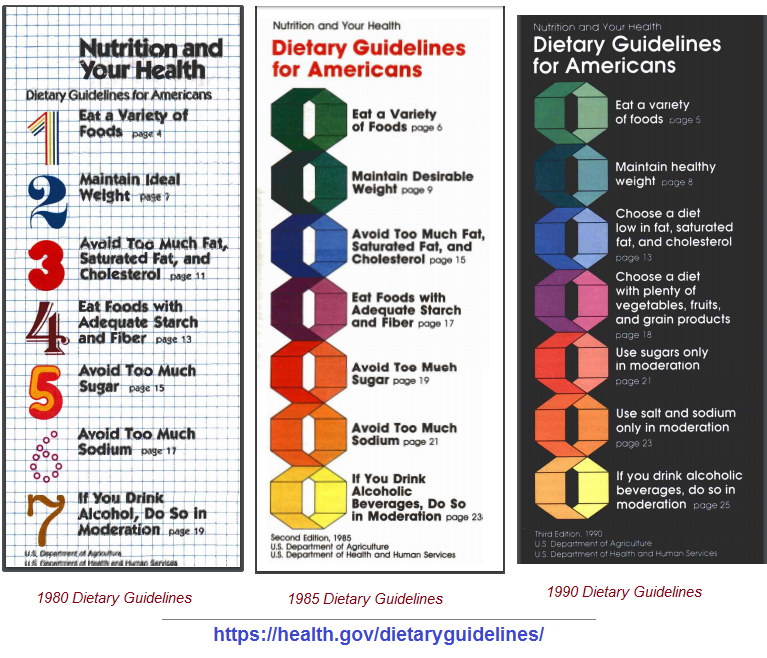
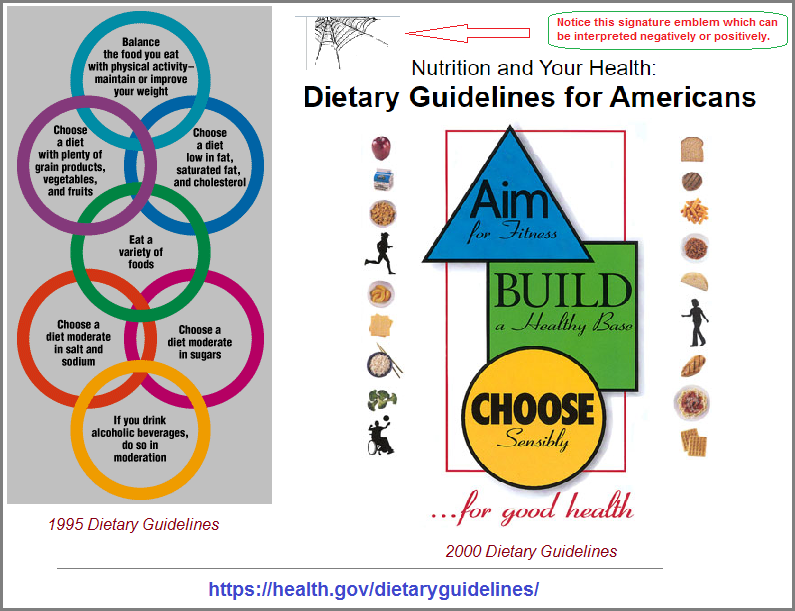
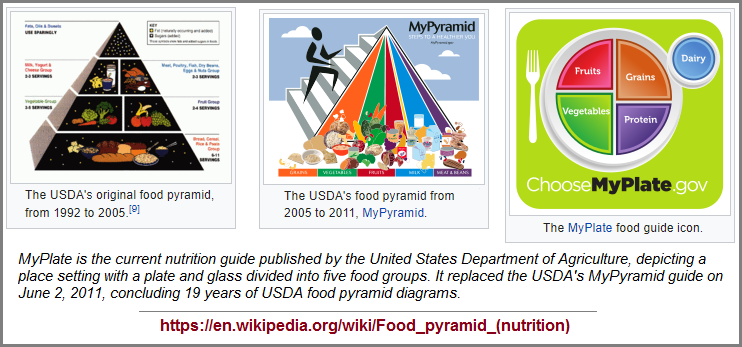


While many countries (but not all) attempt to provide some visual image of simplicity that there respective populations will find easy to understand and identify with, an analysis of the images in terms of thinking about cognitive profiles, we must consider that the depictions may well (metaphorically) describe a change in the government's mental state... or at least those involved in developing the dietary guidelines. The design and emphasis of a given foodstuff, if not correlated with a government interest in selling a particular commercialized commodity that the given nation grows as part of its GNP (Gross National Product) as opposed to its GDP (Gross Domestic Product), needs to be weighed on its own merits: GDP vs. GNP: What's the Difference? by Shobhit Seth, Apr 20, 2019. However, a government's nutrition guidelines, since the world's governments are not Universally identical in describing the same proportions of the same foodstuffs, needs to be firmly addressed by the United Nations efforts to stabilize attitudes and efforts for humanitarian reasons. Unless of course the reason for having different formulas of nutrition guidelines is to say that human physiology is appreciably different from one country to the next. Surely there can be an internationally accepted model of Nutrition so that food distributions can be standardized as a human right.
In contrast to the statement that the world's three main crops provide 40 percent of the world's calories, we have an estimate by the United Nations, according to this article: Wheat 101: Key facts about the world's essential grain, that 20% of the calories consumed by humans comes from wheat, and that by this estimate, this leaves only 20% for Rice and Corn. Yet this article: Crops, by the Environmental Literacy Council, says these three crops provide 60% of the total plant calories consumed by humans. If we can't get the figures right, it is no wonder there are different values being used to develop different nutrition guidelines. Is humanity actually this stupid? It can't really be that difficult to come up with an accurate account of how much of what kinds of crops are actually being used for daily, weekly, monthly and yearly human caloric consumption, instead of lumping all sales of these three crops into a single or even separate accounts involving purchases made by those who use the products for alternative applications. Come on United Nations, get serious! What is wrong with the Researchers you are hiring?... not to mention those working for individual governments.
And now we come to this article: In defense of corn, the world's most important food crop by Tamar Haspel, July 12, 2015, that looks at the importance of crops for feeding humanity in terms of the amount of calories per acre which are produced. Here is the rationale being described:
In the calorie department, corn is king. In 2014, average yield in the United States was 171 bushels per acre. (And the world record is an astonishing 503 bushels, set by a farmer in Valdosta, Ga.) Each bushel weighs 56 pounds and each pound of corn yields about 1,566 calories. That means corn averages roughly 15 million calories per acre. (Again, I'm talking about field corn, a.k.a. dent corn, which is dried before processing. Sweet corn and popcorn are different varieties, grown for much more limited uses, and have lower yields.) If you had taken our 2014 corn harvest of 14.2 billion bushels and used it to feed people, it would have met 17 percent of the entire world's caloric needs.
By contrast, wheat comes in at about 4 million calories per acre, soy at 6 million. Rice is also very high-yielding, at 11 million, and potatoes are one of the few crops that can rival corn: They also yield about 15 million (although record corn yields are much higher than record potato yields). Other vegetables, while much more nutritious than corn, wheat or potatoes, are far less energy-dense. Broccoli yields about 2.5 million calories per acre, and spinach is under 2 million. We all need those vegetables, but we get our full day's worth of nutrition from them in a fraction of the 2,000 daily calories we need to get by, leaving plenty of room for inexpensive, easily grown calories that aren't as nutrient-dense.
However, when we take stock of which commodity is most important, we are faced with a coterie of analysts who may use the dollar signs in their eyes to make a committed referral to a given item other than corn, rice, or wheat as their preference for a stock market choice. Their fiduciary interests out-weigh any concern or consideration for the needs of humanity. If we take stock of a List of most valuable crops and livestock products, we find that the listing describes three headings: 1) global value in billions of dollars, 2) global production in metric tons, 3) top producing country and value (billions of US dollars). There is no listing for how many people are and aren't being served, how many people are nonetheless starving, and how much food is thrown away or otherwise wasted.
(Data is for 2012. The value and production of individual crops varies substantially from year to year as prices fluctuate on the world and country markets and weather and other factors influence production.)
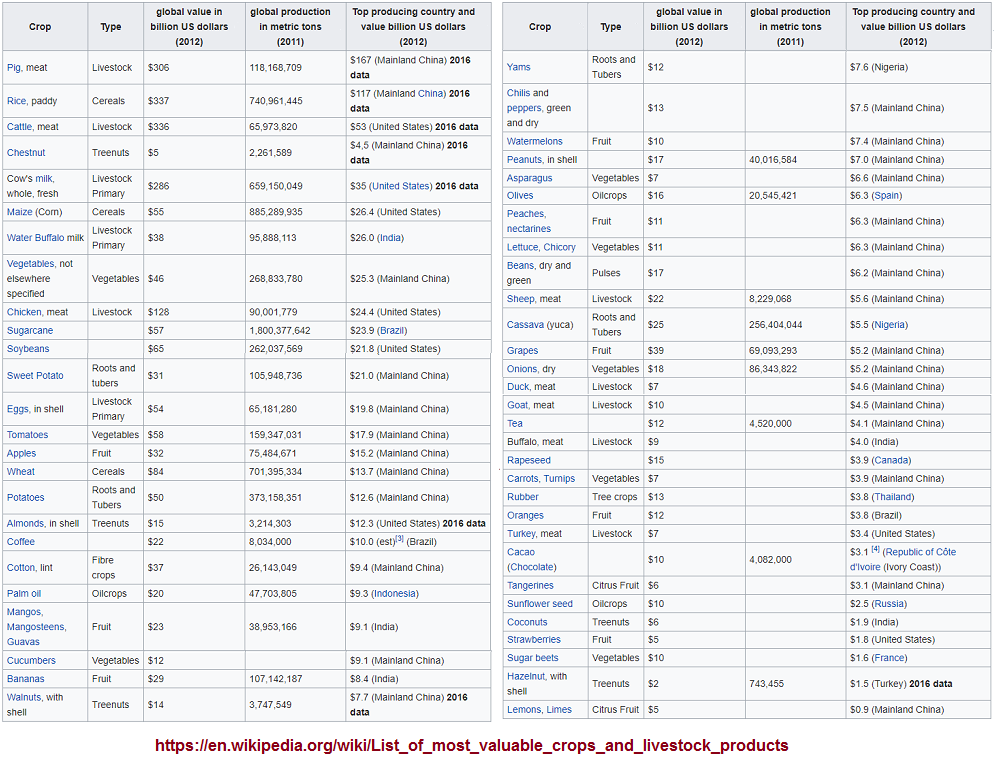
Now we come to the need for some distinctions to be made with respect to the aforementioned three main food crops, where we can start at this reference: C3 & C4 plants by Pierre Laszlo: Corn, Rice and Wheat are called C4 plants that thrive under dry, hot conditions and outperform C3 plants in photosynthetic prowess. C4 plants are said to have arisen in Subtropical climates while C3 plants populated a far broader range of climates. However, if there is enough water and sunlight, C3 plants photosynthetically outperform C4 plants. The "C" refers to the carbon dioxide in air which is converted by plant leaves into a sugar.
The "3 and 4" numbers refer to the quantity of intermediate "middle men" used in the processing procedure. Clearly, in the conditions of global warming, the C4 plants are more valuable than C3 plants for food. However, another way to look at these three plants is to label them as monocots, to distinguish them from dicots:
- A monocot has only one seed leaf (monocot is short for 'monocotyledon'. A cotyledon is a seed leaf, and 'mono' means one). This seed leaf is usually the same shape as the adult leaf, long and thin, and the leaf veins nearly always run parallel to the central midrib. Sometimes, the adult leaves are pinnate, as in many palms, but the veins are parallel on each leaflet. There are several monocot plant families that are instantly recognizable. Many food plants are grasses. So crops like wheat, oats, barley and sweet corn are all monocots. Palms, Orchids, and most bulbous plants are monocots.
Flowers of monocots typically have three petals or multiples thereof.
- A dicot has two cotyledons (dicot is short for 'dicotyledon', and 'di' means two). The seed leaves are usually rounded and fat, because they are the two halves of the seed. The first true leaves can be many different shapes, from long and thin to rounded or palmate. Most trees and shrubs and many garden annuals and perennials are dicots, and there are many more species of dicots than there are monocots.
Flowers of Dicots typically have four or five petals or multiples thereof.
When plants are flowering, we can often distinguish monocots from dicots. Flowers usually have their parts in circles, with the stigma and stamens in the middle, then the petals, with the outer ring, called the calyx, formed by the sepals. In monocots, the parts of the flower are usually in threes. There is usually only one stigma, with three stamens and three petals and three sepals. Very often, the three sepals are the same colour as the petals, and they are joined to them in a single ring, so they look like six petals. When this happens, they are all called tepals. Sometimes, some parts of the flower are missing. For instance, Grasses don't have petals. The flowers of a dicot usually have their parts in fours, or fives, or sixes. There may be the same number of stamens as petals, or there may be more. The calyx is usually in a separate ring under the flower, and is usually green. It may have the same number of sepals as petals, or fewer sepals than petals.
If you could see it, an individual grain of pollen would also give you a clue. The pollen grains of monocots usually have one ridge from top to bottom. Pollen grains of dicots usually have three ridges.
In monocots, the seed pod usually has three parts, because the carpel that they grew from has three parts. The seed pods of dicots can have just one part or many parts.
Monocots and Dicots: Differences and Similarities
Please note the absence of a "Trichot" category, though such a condition is not unheard of as described here: A seedling with three (instead of two) cotyledons.
Of the three main divisions of angiosperms (the other two being the basal angiosperms and monocots), the eudicots are evolutionarily the most advanced and are in fact the most advanced plants on Earth. Their superior adaptations have allowed them to dominate the majority of land-based ecosystems both in terms of diversity and biomass: EUDICOTS
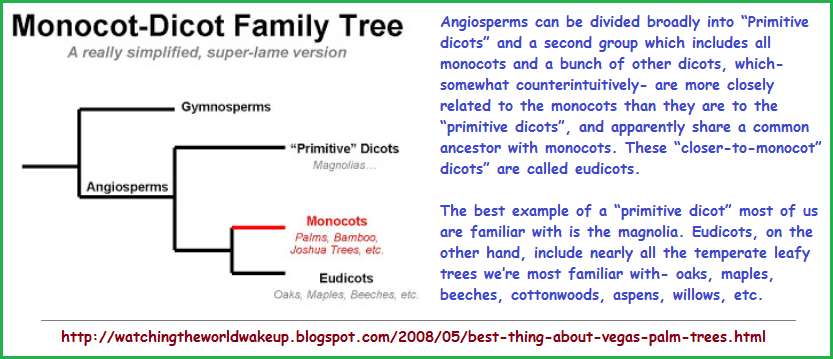
Here is some additional information on C3 and C4 plants culled from the Penguin dictionary of Plant Sciences, second edition, edited by Jill Bailey. ISBN 0-14-051403-1, page 68:
C4 plants require 30 molecules of ATP (Adenosine Triphosphate) and 24 molecules of water to synthesize a molecule of glucose while C3 plants need only 18 molecules of ATP and 12 molecules of water. However, C4 plants produce more glucose for a given leaf area than C3 plants and consequently grow more quickly. They can also continue to photosynthesize at high light intensities and low carbon dioxide concentrations, and most significantly, do not exhibit photorespiration.
When speaking of plants, a closer look at photosynthesis is warranted since it permits us to recognize an intermediate or alternative type of plant called CAM, which is an abbreviation for crassuclacean acid metabolism:
CAM is a form of photosynthesis first described in the Crassulaceae and since found in many other succulent plants. CAM plants keep their stomata closed during the day to reduce water loss by respiration... page 117, Penguin dictionary of plant sciences.
Specific variations in photosynthesis
Chlorophylls a and b (bound to a protein) and carotenes constitute the principal light-absorbing complex of most plants. Differences in chloroplast structure, though not major, occur among phylogenetically diverse plant groups. All such variations, however, represent evolutionary adaptations to utilize more efficiently the light energy that drives the reactions common to all oxygenic photosynthesizers, i.e., photosystems I and II.
The enzyme ribulose 1,5-bisphosphate carboxylase/oxygenase (rubisco) catalyzes the formation of organic molecules from CO2. As the major enzyme of all photosynthetic cells, rubisco is probably the most abundant protein on the Earth. There is, however, a major catalytic flaw in the ability of this enzyme to convert CO2 to sugars. In the presence of molecular oxygen, rubisco catalyzes reactions in which oxygen is introduced (i.e., it acts as an oxygenase), and CO2 is formed rather than converted.
Rubisco evolved in photosynthetic organisms that lived in the atmosphere of primitive Earth, an atmosphere which contained only traces of molecular oxygen. As photosynthesis in the Cyanobacteria of Precambrian times (before 542 million years ago) oxygenated the atmosphere, the ratio of carbon dioxide to oxygen fell drastically, and rubisco began to function more and more as an oxygenase. This greatly reduces the net fixation of CO2 into sugars and, therefore, photosynthetic efficiency. Rubisco as an oxygenase only splits RuBP into PGA and the two-carbon acid phosphoglycolate, which initiates the photorespiratory carbon-oxidation cycle, or photorespiration. (This cycle probably evolved to recycle PGA (phosphoglyceric acid [glycerate 3-phosphate]) back into the photosynthetic pathway, thereby preventing an even greater loss of carbon.)
Photorespiration involves three organelles (chloroplasts, peroxisomes, and mitochondria), each with unique transport mechanisms for the cycle's intermediates.
All plants are classified as:
- C3 (plants that use only the Calvin-Benson cycle).
- C4 (plants that use an additional CO2-fixation mechanism and the Calvin-Benson cycle).
- C3-C4 (plants intermediate between C3 and C4).
- CAM (plants that have a variant of the C4 pathway).
The majority of plants fix CO2 directly into RuBP, and their first stable product is the three-carbon acid PGA, hence the designation C3. These plants have an active photorespiratory cycle, especially in high light intensity and warm temperatures.
Sometime during the later periods of the Cenozoic Era (65.5 million years ago to the present), certain of the angiosperms (grasses and the dicotyledonous plants) of mainly tropical climates evolved a CO2-fixation system that precedes the Calvin-Benson cycle. The first fixation is into the three-carbon acid phosphoenolpyruvate (PEP) by PEP carboxylase (an enzyme that has no oxygenase function) in the outer mesophyll cells of the leaf. The first stable fixation product is the four-carbon acid oxaloacetate, hence the designation C4 plants. Oxaloacetate is converted to malate, which is transferred to a thick-walled bundle sheath cell that shields the subsequent reactions from the high concentration of molecular oxygen in the atmosphere. Malate is decarboxylated, and rubisco of the primitive and susceptible Calvin-Benson cycle functions more efficiently because here photorespiration is suppressed. There is thus a spatial separation of initial CO2 fixation and the Calvin-Benson cycle. This efficiency is not without cost, however, as an additional ATP is required to recycle PEP. For this reason, C3 plants may be more efficient in cold climates with less light (and, therefore, less photorespiration).
There are also plants with enzymatic and leaf anatomical characteristics intermediate between C3 and C4 plants, called C3-C4 intermediate species. These plants are thought to be in the pathway of evolution to full C4 photosynthetic status.
Source: "plant." Encyclopædia Britannica Ultimate Reference Suite, 2013.
Origination date: Friday, November 22th, 2019... 10:28 AM
Initial Posting: Saturday, Novermber 29th, 2019... 1:00 PM
Updated Posting: Friday, January 20th, 2023... 12:42 PM
Herb O. Buckland
herbobuckland@hotmail.com
